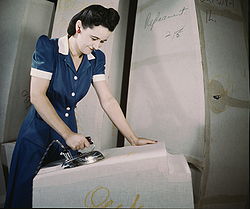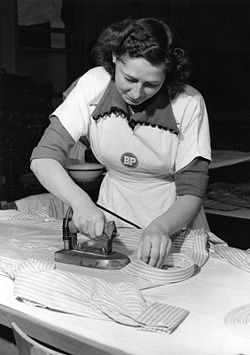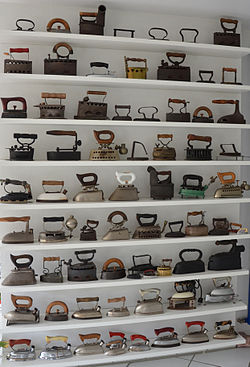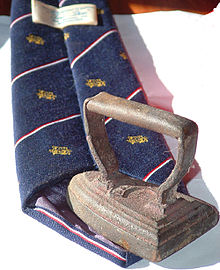- Ironing
-
For other uses, see Ironing (disambiguation).
Ironing is the use of a heated tool (an iron) to remove wrinkles from fabric. The heating is commonly done to a temperature of 180-220 °Celsius, depending on the fabric.[1] Ironing works by loosening the bonds between the long-chain polymer molecules in the fibers of the material. While the molecules are hot, the fibers are straightened by the weight of the iron, and they hold their new shape as they cool. Some fabrics, such as cotton, require the addition of water to loosen the intermolecular bonds. Many modern fabrics (developed in or after the mid-twentieth century) are advertised as needing little or no ironing. Permanent press clothing was developed to reduce the ironing necessary by combining wrinkle-resistant polyester with cotton.
The first known use of metal to "iron" clothes, however, is known to have occurred in China[2] The electric iron was invented in 1882, by Henry W. Seeley. Seeley patented his "electric flatiron" on June 6, 1882 (U.S. Patent no. 259,054).[3]
Contents
Equipment
Charcoal irons, used by eestri wala's, which are still in use commercially in India.
Iron
Main article: Clothes iron American woman ironing.
American woman ironing.
The iron is the small appliance used to remove wrinkles from fabric. It is also known as a clothes iron, flat iron, or smoothing iron. The piece at the bottom is called a sole plate.
Ironing board
Most ironing is done on an ironing board, a small, portable, foldable table with a heat resistant surface. Some commercial-grade ironing boards incorporate a heating element and a pedal-operated vacuum to pull air through the board and dry the garment.
On 16 February 1858 W. Vandenburg and J. Harvey patented an ironing table that facilitated pressing sleeves and pant legs.[4] A truly portable folding ironing board was first patented in Canada in 1875 by John B. Porter. The invention also included a removable press board used for sleeves.[5] In 1892 Sarah Boone obtained a patent in the United States for improvements to the ironing board, allowing for better quality ironing for shirt sleeves.[6]
Tailor's ham
A tailor's ham or dressmakers ham is a tightly stuffed pillow in the shape of a ham used as a mold when pressing curves such as sleeves or collars.
Commercial equipment
Commercial dry cleaning and full-service laundry providers usually use a large appliance called a steam press to do most of the work of ironing clothes. Alternately, a rotary iron may be used.
-
Antique iron from Kerala
Historically, larger tailors' shops included a tailor's stove, a stove used by tailors to quickly and efficiently heat multiple irons. In many developing countries a cluster of solid irons, heated alternatively from a single heating source, are used for pressing cloths at small commercial outlets. LPG operated Iron made by K. Linga Brahmam can be a good alternative.[7]
Recommended ironing temperatures
Textile Temperature[citation needed] Temperature[1] Dot mark Toile 240 °C Triacetate ("Estron", "Silene", "Tricell") 200 °C 220-250 °C Cotton 204 °C / 400 °F 180-220 °C * * * [8] Linen (flax) 215-240 °C * * * [8] Viscose/Rayon 190 °C 150-180 °C * * [8] Wool 148 °C / 300 °F 160-170 °C * * [9] Polyester 148 °C / 300 °F * [8] Silk 148 °C / 300 °F 140-165 °C * [9] SympaTex * [8] Acetate ("Arnel", "Celco", "Dicel") 143 °C 180 °C * [9] Acrylic 135 °C 180 °C Lycra/Spandex 135 °C Nylon-6 150 °C Nylon-66 180-220 °C Dot mark Temperature * < 110 °C * * < 150 °C * * * < 200 °C Another source suggests slightly higher temperatures, for example, 180-220 °C for cotton[1]
Chemistry
When the fabric is heated, the molecules are more easily reoriented. In the case of cotton fibres, which are derivatives of cellulose, the hydroxyl groups that crosslink the cellulose polymer chains are reformed at high temperatures, and become somewhat "locked in place" upon cooling the item. In permanent press pressed clothes, chemical agents such as dimethylol ethylene urea are added as crosslinking agents.
See also
References
- ^ a b c Fritz Schultze-Gebhardt,Karl-Heinz Herlinger "Fibers, 1. Survey" in Ullmann's Encyclopedia of Industrial Chemistry, Wily-VCH, Weinheim, 2000. doi:10.1002/14356007.a10_451
- ^ Oldandinteresting.com
- ^ Enchantedlearning.com
- ^ U.S. Patent 19,390
- ^ Mario Theriault, Great Maritime Inventions 1833-1950, Goose Lane, 2001, p. 31
- ^ Mary Bellis (2011). "Sarah Boone". Inventors. About.com. http://inventors.about.com/library/inventors/blboone.htm. Retrieved 13 November 2011.
- ^ Gas (LPG) Operated Iron (Press) National Innovation Foundation retrieved on 2011-04-20.
- ^ a b c d e "Bra att veta vad man har på sig.. Ulla Popken". http://images01.ullapopken.de/resources/bilder/se/se/pflegetipps/pflegefibel.pdf. 100204 ullapopken.de
- ^ a b c "Lanidor, General care". http://eshop.lanidor.com/Files/care_instructions_uk.pdf. 100204 eshop.lanidor.com
External links
- History of Ironing from oldandinteresting.com
- Theory and Technology of Ironing
- Charcoal and other antique irons from the White River Valley Museum
- Antique Irons from the Virtual Museum of Textile Arts
Categories:- Domestic implements
- Laundry
- Home appliances
Wikimedia Foundation. 2010.








